 Author: Eiji OKUBO Sales Network: Amazon.com / Amazon.co.jp |
| Written by Eiji Okubo, Printed books and e-books Heritage of Minoan and Mycenaean civilizations Detailed data on Ruins and Excavated items |
| Legacy of the Mycenaean Civilization 230 carefully selected Excavated Items |
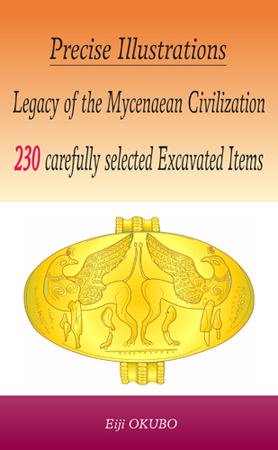 |
| subtitle: Touring to Mycenaean civilization with precise illustrations
of excavated artefacts language: English format: e-book / Web-download to Amazon-kindle, PC, e-book-reader, tablet-device, mobile-phone size: 288 pages (kindle screen) / capacity: 367Mb sales: Amazon Network / Amazon.com / Amazon.co.uk |
| Sumary: This e-book is written in English, a "Precision Illustration & Data Book" of the main excavated items from the Prehistoric Mycenaean Civilization ruins in Greece. This e-book picks up "200 carefully selected excavated items" found in important archaeological sites such as the Peloponnese Argolis region and Messenia region, mainly the Mycenae Palace ruins, which was the largest center of the Mycenaean Civilization. More than 90% of the excavated items in this e-book explained are depicted in Precise Illustrations, and the rest are published in Photographs. This e-book will invite you to the "World of Crafts and Arts" of the Mycenaean Civilization through important works carefully selected from among the countless excavated artifacts exhibited at the National Archaeological Museum of Athens and other archaeological museums throughout Greece. |
| Sample Page:(excerpt) ---------- Eye-popping jewelry goods excavated from in the Mycenaean Palace and the surrounding ruins of the Mycenaean civilization, especially gold jewelry items have been found those who owned them to have lived in the palace, judging from the preciousness of the material, the style, and motifs expressed in the works. It can be concluded that they, owners of gold jewelry, were extremely noble people such as members of the royal family, their relatives, and of the nobility class. In addition, if it limits to the excavated items of high-quality jewelry, the number of unearthed articles is slightly less from the ruins of palace buildings or mansions, but most of them have come from the excavation of tombs inside and near the palace, where royal families and nobles were buried. II-1-01 Gold Goblet 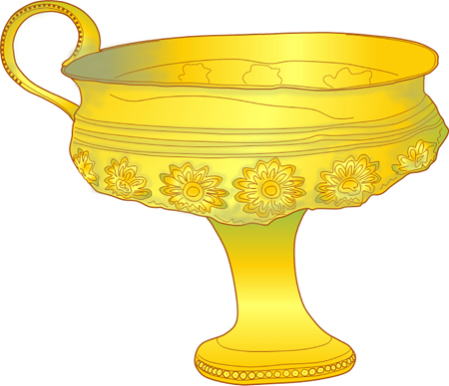 Site: Shaft Grave IV, GCA, Mycenae Palace Shape & Decoration: Gold Goblet with ring-handle, rosettes in repoussé, granulation technique Era: LHI, ca. 1550 BC Museum: NAM, inv. No. 351 Local: Argolis, Peloponnese 11km north-northwest from Argos town / 90km west-southwest from Athens Drawing: Eiji OKUBO Related: Grave Circle A (GCA), Mycenae Palace In 1876, German businessman J.H. Schliemann discovered a double stone slab circle with a maximum outer diameter of 27.5 m inside the citadel of the Mycenae Palace ruins in the Peloponnese-Argolis region, currently a UNESCO World Heritage Site. The circular ruins were a large cemetery called "Grave Circle A," which dates back to the 16th century BC. Grave Circle A in the Mycenae Palace is located immediately to the right of the interior after entering through the Lion Gate, the main gate of the palace area. In Grave Circle A, the Shaft Grave I to Grave V were discovered during Schliemann's excavation work, and later the Shaft Grave VI was discovered by Greek researcher Panagiotis Stamatakis. Schliemann called initially this area of Grave Circle A the "Agora" which later meant a public square and market place in Ancient Greece. 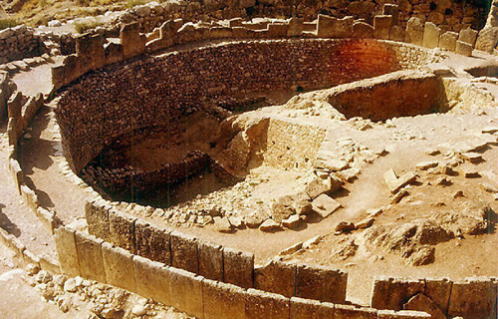 Site: Grave Circle A, Mycenae Palace Situation: A unique Mycenaean cemetery a) double slab circle=outer diameter 27.5m, inner 25m b) center left tomb=largest Shaft Grave IV c) center right tomb=Shaft Grave I Era: MHIII-LHI, 1625-1500 BC Local: Argolis, Peloponnese / 11km north-northeast from Argos city Photo: 1982 GPS: 37°43'49.50''N 22°45'23''E / ALT 240m 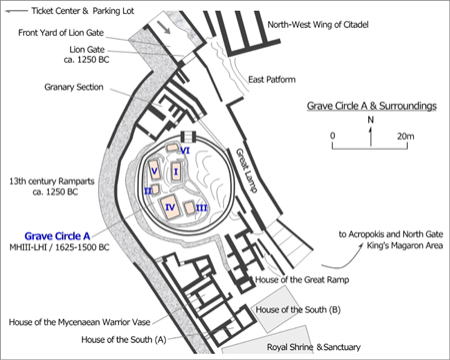 Site: Plan of Grave Circle A & surroundings, Mycenae Palace Local: Argolis, Peloponnese Drawing: Eiji OKUBO Grave Circle A had a structure in which double circle-shaped stone slabs surrounded the ground surface. The stone slab circle is not a perfect circle, but a slightly distorted, almost circular shape, with the maximum outer diameter of the outer circle being approximately 27.5m, and the inner diameter of the inner circle being about 25m. A total of 19 bodies had been buried in Grave Circle A, including eight adult men, nine women, and two children. The burial persons are undoubtedly members of the second or third generation of the royal family who lived in the Mycenae Palace approximately 3,600 to 3,500 years ago, or members of the royal family or relatives, such as the king's brothers. Burial bodies in GCA: Shaft Grave I: 3 women Shaft Grave II: 1 man Shaft Grave III: 3 women and 2 children Shaft Grave IV: 3 men and 2 women Shaft Grave V: 3 men Shaft Grave VI: 1 man and 1 woman II-1-02 Gold Cup 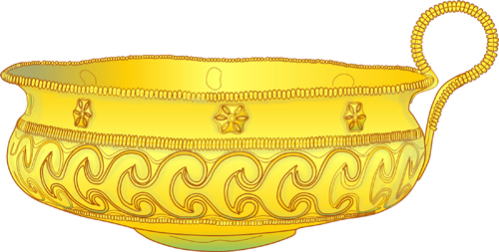 Site: Chamber Tomb 10, Dendra Shape & Decoration: Gold Cup, impressed decoration of ivy & rosette patterns granulation technique Era: LHIIIA1, 1400-1375 BC Museum: NAM, inv. No. 8743 mouth diameter D130mm, height H50mm excluding handle Local: Argolis, Peloponnese / 7km north-northeast from Tiryns Palace Drawing: Eiji OKUBO GPS: 37°39'24''N 22°49'32''E / ALT 60m II-2-09 Gold Seal 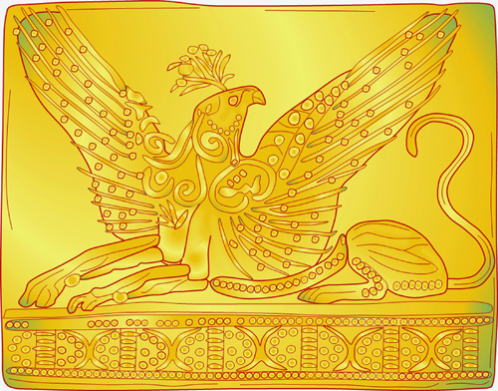 Site: Royal Tholos Tomb IV, Nestor’s Palace Shape & Decoration: Gold Seal, cushion shape intaglio, a griffin spreading wings, triglyph pattern back side=diamond (mesh) pattern Era: MHIII-LHIIA, 1650-1450 BC Museum: NAM, inv. No. 7986 / L27mm, W21mm, T6mm Local: Messenia, Peloponnese<br> 13km north from Pylos port, 35km west from Kalamata city Drawing: Eiji OKUBO Royal Tholos Tomb IV, Nestor’s Palace 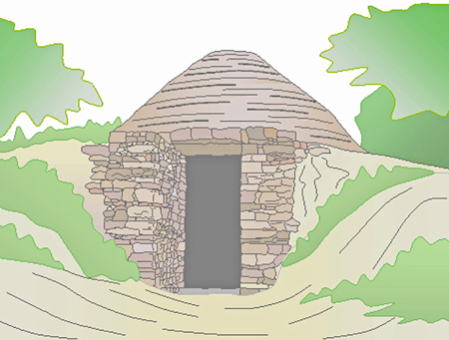 Site: Royal Tholos Tomb IV, Nestor’s Palace (as of 1982) Situation: from Dromos to Entrance a) Tholos chamber: Semi-underground type, inner diameter 9.35m b) ceiling: concrete restoration Era: MHIII-LHIIIA a) 1650-1450 BC=continuous burial for 200 years b) 1450-1350 BC=intermittent burial for 100 years Local: Messenia, Peloponnese / 13km north from Pylos port Drawing: Eiji OKUBO GPS: 37°01'38''N 21°41'42''E / ALT 195m A total of 19 people of the highest rank of the Mycenae Palace, including kings, queens, and members of the royal family, had been buried in the Grave Circle A. During Schliemann’s excavations, from the GCA, multiple gold death masks that covered the face of male burials and beautiful form gold cups were excavated, as well as gold crowns, and dazzling jewelry such as earrings and necklaces that would have been worn by female royals. In addition, an endless number of finely decorated daggers inlaid with gold and special metals, various silverware and bronze vessels, and many ceramics with a characteristic pattern of the early Mycenaean civilization have been unearthed from Shaft Graves of the GCA. II-3-01 Gold Death-mask  Site: Shaft Grave V, GCA, Mycenae Palace Shape & Decoration: Gold Death-mask, in repoussé Excavator J.H. Schliemann's conjecture: “Gold Mask of Agamemnon,” 13th century BC scholar's judgment: Death-mask of a "King" over 300 years older than "King Agamemnon" Era: LHI, ca. 1550 BC Museum: NAM, inv. No. 624 / H250mm, weight 168.5g Local: Argolis, Peloponnese Photo: 1987 II-3-03 Electrum alloy Death-mask  Site: Shaft Grave Γ, GCB, Mycenae Shape & Decoration: Electrum alloy Death-mask, made by gold & silver alloy, in repoussé a burial good of the pioneering of "mask-covered burial" in the Early Mycenaean period Era: MHIII, 1625-1550 BC Museum: NAM, inv. No. 8709 / H240mm Local: Argolis, Peloponnese Drawing: Eiji OKUBO V-05 Bronze Dagger, “Tangles type” 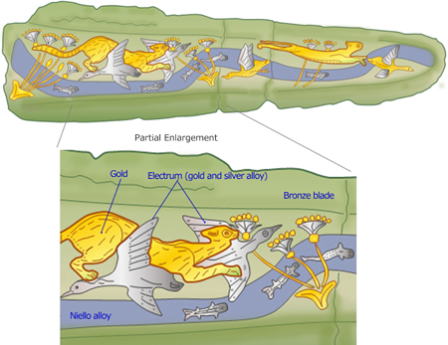 Site: Shaft Grave V, GCA, Mycenae Palace Shape & Decoration: Bronze Dagger of the “Tangles type,” with inlaid decoration of gold, niello, electrum alloy two lions (or leopards) attacking waterfowl, fish swimming in the river Era: LHI, ca. 1550 BC Museum: NAM, inv. No. 765 / L165mm Local: Argolis, Peloponnese Drawing: Eiji OKUBO VI-1-05 Spherical Jug 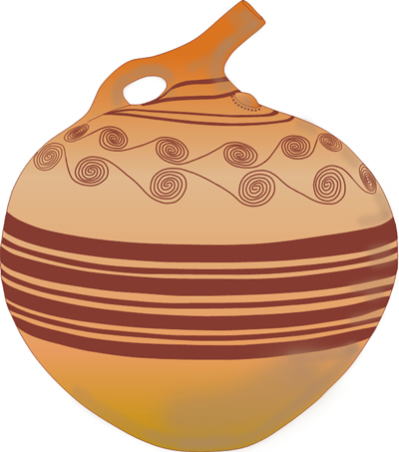 Site: Shaft Grave II, GCA, Mycenae Palace Shape & Decoration: Spherical Jug, horizontal line pattern and chained spiral Era: MHIII, 1625-1550 BC Museum: NAM, inv. No. 200 / H295mm Local: Argolis, Peloponnese Drawing: Eiji OKUBO VI-4-01 Pictorial style, Krater with leg 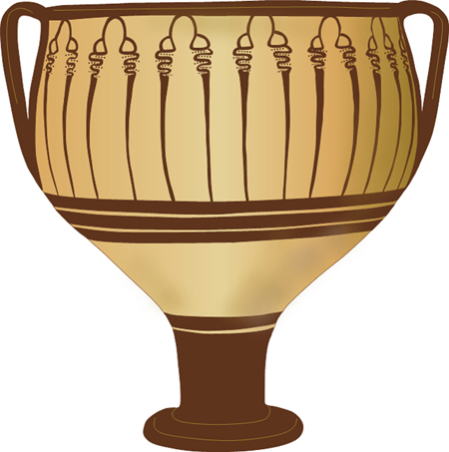 Site: Citadel, Mycenae Palace Shape & Decoration: Pictorial style, Krater with leg, whorl-shell pattern Era: LHIIIB1, 1300-1250 BC Museum: NAM, inv. No. 1148 / H370mm Local: Argolis, Peloponnese Drawing: Eiji OKUBO VIII-06 Fresco “Goat-headed Daemons” 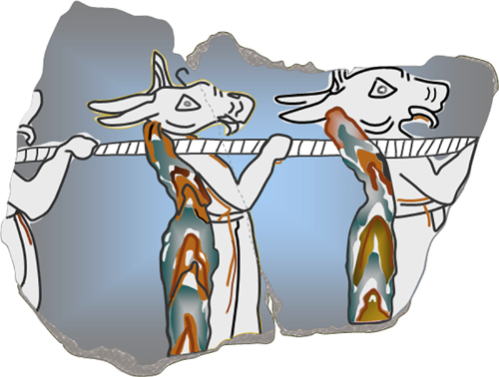 Site: House of Tsountas, Citadel, Mycenae Palace Shape & Decoration: Fresco “Goat-headed Daemons carrying palanquin poles” Era: LHIIIA2-LHIIIB1, 1375-1250 BC Museum: NAM, inv. No. 2665 / L100mm Local: Argolis, Peloponnese Drawing: Eiji OKUBO IX-12 Agate Seal  Site: Room of the Idols、Sanctuary, Mycenae Palace Shape & Decoration: Circular lens-shaped Agate Seal, two bulls and a leaping man Era: LHIIIB2, 1250-1200 BC Museum: NFAM, inv. No. 69-813 / L22mm (currently: MYAM, inv. No. 1861) Local: Argolis, Peloponnese Drawing: Eiji OKUBO X-01 Minoan style Alabaster Vase 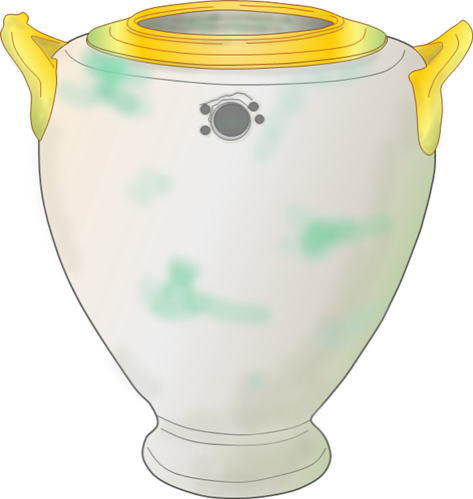 Site: Shaft Grave V, GCA, Mycenae Palace Shape & Decoration: Made in Egypt, Minoan style Alabaster vase gold coving the mouth and handles Era: LHI, ca. 1550 BC Museum: NAM, inv. No. 829 / H170mm Local: Argolis, Peloponnese Drawing: Eiji OKUBO XII-03 Ivory Statue of Female or Goddess 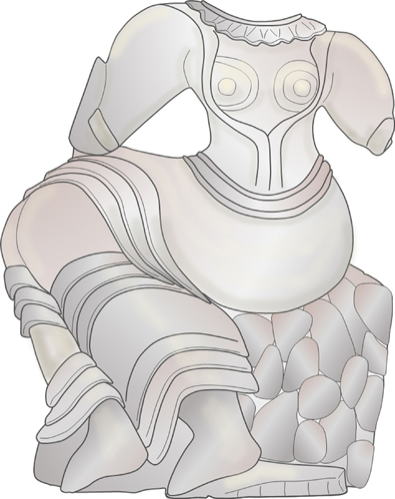 Site: Citadel, Mycenae Palace Shape & Decoration: Ivory Statue of Female or Goddess, sitting quietly on a rock Era: LHII-LHIIIA, 1500-1300 BC Museum: NAM, inv. No. 5897 / H85mm Local: Argolis, Peloponnese Drawing: Eiji OKUBO ---------- |